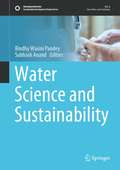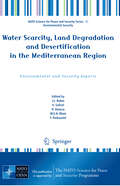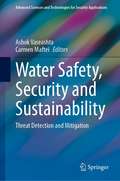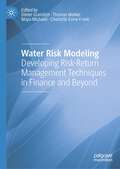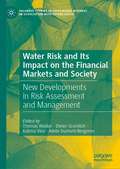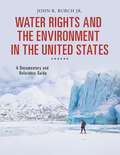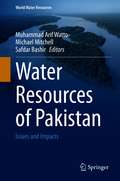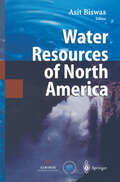- Table View
- List View
Water Science & Technology in China: A Roadmap to 2050
by Changming Liu Yi Wang Mingan Shao Xiyong HouAs one of the eighteen field-specific reports comprising the comprehensive scope of the strategic general report of the Chinese Academy of Sciences, this sub-report addresses long-range planning for developing science and technology in the field of water science. They each craft a roadmap for their sphere of development to 2050. In their entirety, the general and sub-group reports analyze the evolution and laws governing the development of science and technology, describe the decisive impact of science and technology on the modernization process, predict that the world is on the eve of an impending S&T revolution, and call for China to be fully prepared for this new round of S&T advancement. Based on the detailed study of the demands on S&T innovation in China's modernization, the reports draw a framework for eight basic and strategic systems of socio-economic development with the support of science and technology, work out China's S&T roadmaps for the relevant eight basic and strategic systems in line with China's reality, further detail S&T initiatives of strategic importance to China's modernization, and provide S&T decision-makers with comprehensive consultations for the development of S&T innovation consistent with China's reality. Supported by illustrations and tables of data, the reports provide researchers, government officials and entrepreneurs with guidance concerning research directions, the planning process, and investment. Founded in 1949, the Chinese Academy of Sciences is the nation's highest academic institution in natural sciences. Its major responsibilities are to conduct research in basic and technological sciences, to undertake nationwide integrated surveys on natural resources and ecological environment, to provide the country with scientific data and consultations for government's decision-making, to undertake government-assigned projects with regard to key S&T problems in the process of socio-economic development, to initiate personnel training, and to promote China's high-tech enterprises through its active engagement in these areas.
Water Science and Sustainability (Sustainable Development Goals Series)
by Bindhy Wasini Pandey Subhash AnandThis book describes the importance of water resources for socio-economic and ecological development including geomorphic and ecological environments. Hence, conservation, management and development of water resources have become necessary for the all-around development of global populations and the environment. It is the outcome of valuable contributions made by eminent scientists and research scholars who have developed alternative strategies, solutions and models for sustainable water resources through research, monitoring and experiments varying from regional to global scale. This book is of immense use to the policymakers, environmentalists, ecologists, academician, research scholars and people in general concerned with water resources management.
Water Scarcity, Livelihoods and Food Security: Research and Innovation for Development (Earthscan Studies in Water Resource Management)
by Larry W. Harrington Myles J. FisherThis volume reviews the evolution of ten years’ learning and discovery about water scarcity, livelihoods, and food security within the CGIAR Challenge Program on Water and Food. It draws on the experiences of over 100 projects conducted in ten river basins in the developing world. The book describes how the program’s design evolved from an emphasis on water scarcity, water productivity, and water access to an emphasis on using water innovations to improve livelihoods and address development challenges in specific river basins. It shows how the research was used to foster change in stakeholder behavior, linking it to improved knowledge, attitudes, and skills, which were fostered by stakeholder participation, innovation, dialogue, and negotiation. The authors describe development challenges, their drivers and their political context, how to address them through technical, institutional, and policy innovations; and the consequences of change at different scales, time frames on equity, resilience, and ecosystem services. Overall, the work represents a major synthesis and landmark publication for all concerned with water resource management and sustainable development.
Water Scarcity, Livelihoods and Food Security: Research and Innovation for Development (Earthscan Studies in Water Resource Management)
by Larry W. Harrington Myles J. FisherThis volume reviews the evolution of ten years’ learning and discovery about water scarcity, livelihoods, and food security within the CGIAR Challenge Program on Water and Food. It draws on the experiences of over 100 projects conducted in ten river basins in the developing world. The book describes how the program’s design evolved from an emphasis on water scarcity, water productivity, and water access to an emphasis on using water innovations to improve livelihoods and address development challenges in specific river basins. It shows how the research was used to foster change in stakeholder behavior, linking it to improved knowledge, attitudes, and skills, which were fostered by stakeholder participation, innovation, dialogue, and negotiation. The authors describe development challenges, their drivers and their political context, how to address them through technical, institutional, and policy innovations; and the consequences of change at different scales, time frames on equity, resilience, and ecosystem services. Overall, the work represents a major synthesis and landmark publication for all concerned with water resource management and sustainable development.
Water Scarcity, Land Degradation and Desertification in the Mediterranean Region: Environmental and Security Aspects (NATO Science for Peace and Security Series C: Environmental Security)
by Uriel Safriel Raul Daussa Winfried Blum Fausto Pedrazzini Jose RubioBased on the suggestions made by the speakers of Plenary Session IV “Ch- lenges to the management of water resources and to countering deserti cation in the Mediterranean region” during the 15th Economic and Environmental Forum, the OCEEA proposed to organize a workshop on “Water Scarcity, Land Degra- tion and Deserti cation in the Mediterranean region – Environment and Security Aspects”. In order to build on common synergies, OSCE sought co-operation with c- leagues from NATO, in particular from the Science for Peace and Security P- gramme. NATO has a longstanding expertise on the issue and had organised in Valencia, in December 2003, a NATO scienti c workshop on “Deserti cation and Security in the Mediterranean Region”. The objective of the new proposed wo- shop would be to broaden its focus from the scienti c community to include also policy makers. 1 The workshop, aimed at government of cials from the Mediterranean Region, gathered representatives of Water management, Land degradation and Desert- cation Departments of Ministries of Environment and representatives from the Ministries of Foreign Affairs. In addition, policy makers, scientists and experts were also invited. The aim was to discuss how the OSCE, NATO and other c- petent organizations like the UNCCD, UNEP, MAP, and the EU could play a role in ensuring that environment and security linkages in terms of water scarcity, land degradation and deserti cation are addressed in the Mediterranean Region.
Water Scarcity in the Mediterranean: Perspectives Under Global Change (The Handbook of Environmental Chemistry #8)
by Sergi Sabater Damià BarcelóWater scarcity affects hydrologic resources, systems connectivity, biodiversity, water quality, and river ecosystem functioning. It has direct impacts on economic sectors that use and depend on water, such as agriculture, tourism, industry, energy and transport. The Mediterranean Basin is one of the regions in the world most vulnerable to climate changes, as well as one of the most impacted by human water demand. This volume provides an in-depth view of the water quality and quantity implications of water scarcity. It highlights its possible causes and describes the effects in regions under Mediterranean climate. The topics covered include climate effects, water resources (use, storage and new sources), water quality (chemical and microbiological), and the effects on ecosystems suffering from water scarcity. This book is addressed to scientists and students, but also to managers involved in the necessary decision making process to face future periods of drought.
Water Scarcity, Climate Change and Conflict in the Middle East: Securing Livelihoods, Building Peace (International Library of Human Geography)
by Sandra Rucksthuhl Christopher WardThe countries that make up the MENA region display wide diversity. One of the poorest countries in the world sits alongside two of the wealthiest, whilst the region's natural resources range from immeasurable oil and gas reserves to some of the scantiest natural endowments anywhere in the world. Yet through this diversity runs a common thread: water scarcity. Now, through the impact of human development and climate change, the water resource itself is changing,bringing new risks and increasing the vulnerability of all those dependent on water. Chris Ward and Sandra Ruckstuhl assess the increased challenges now facing the countries of the region, placing particular emphasis on water scarcity and the resultant risks to livelihoods, food security and the environment. They evaluate the risks and reality of climate change in the region, and offer an assessment of the vulnerability of agriculture and livelihoods. In a final section, they explore the options for responding to the new challenges, including policy, institutional, economic and technical measures.
Water Scarcity and Conflict in African River Basins: The Hydropolitical Landscape (Earthscan Studies in Water Resource Management)
by Mahlakeng Khosi MahlakengThe book presents a critical and comparative analysis of the hydropolitical landscape of African transboundary river basins which, for much of the past century, have been affected by water scarcity. River and lake basins can become a source of tension and conflict due to a complicated mix of environmental, demographic, diplomatic, historical and geopolitical factors. This book, however, specifically focuses on the important, and often under looked, role played by scarcity in generating or exacerbating conflicts in shared river basins. Asserting that transboundary river basins tie states into a web of interdependence, this book raises awareness of how water scarcity, or the depletion of water resources, complicates this relationship as nations are forced to look beyond their own borders to meet the demand for water to satisfy multiple needs. Taking a comparative approach, it examines three shared basins: the Orange-Senqu, the Nile and the Niger River basins. While situated in different regions, all three basins are marked by serious environmental challenges that are detrimental to combustible hydropolitics over such shared water resources and they provide fascinating insights into the links between climate variability and change, water resources, human security, conflict, adaptation and regime capacity. Overall, this book argues that conflict over transboundary resources can be prevented given the establishment of norms, rules, and the role of external actors that help regulate state behaviour and control their impacts. This book will be of great interest to students and scholars of water resource management, hydropolitics, environmental conflict, resource scarcity and international relations. It will also be of interest to policymakers involved in transboundary water resource governance.
Water Scarcity and Conflict in African River Basins: The Hydropolitical Landscape (Earthscan Studies in Water Resource Management)
by Mahlakeng Khosi MahlakengThe book presents a critical and comparative analysis of the hydropolitical landscape of African transboundary river basins which, for much of the past century, have been affected by water scarcity. River and lake basins can become a source of tension and conflict due to a complicated mix of environmental, demographic, diplomatic, historical and geopolitical factors. This book, however, specifically focuses on the important, and often under looked, role played by scarcity in generating or exacerbating conflicts in shared river basins. Asserting that transboundary river basins tie states into a web of interdependence, this book raises awareness of how water scarcity, or the depletion of water resources, complicates this relationship as nations are forced to look beyond their own borders to meet the demand for water to satisfy multiple needs. Taking a comparative approach, it examines three shared basins: the Orange-Senqu, the Nile and the Niger River basins. While situated in different regions, all three basins are marked by serious environmental challenges that are detrimental to combustible hydropolitics over such shared water resources and they provide fascinating insights into the links between climate variability and change, water resources, human security, conflict, adaptation and regime capacity. Overall, this book argues that conflict over transboundary resources can be prevented given the establishment of norms, rules, and the role of external actors that help regulate state behaviour and control their impacts. This book will be of great interest to students and scholars of water resource management, hydropolitics, environmental conflict, resource scarcity and international relations. It will also be of interest to policymakers involved in transboundary water resource governance.
Water Safety, Security and Sustainability: Threat Detection and Mitigation (Advanced Sciences and Technologies for Security Applications)
by Ashok Vaseashta Carmen MafteiThis book focuses on threats, especially contaminants, to drinking water and the supply system, especially in municipalities but also in industrial and even residential settings. The safety, security, and suitability landscape can be described as dynamic and complex stemming from necessity and hence culpability due to the emerging threats and risks, vis-a-vis globalization resulting in new forms of contaminants being used due to new technologies. The book provides knowledge and guidance for engineers, scientists, designers, researchers, and students who are involved in water, sustainability, and study of security issues. This book starts out with basics of water usage, current statistics, and an overview ofwater resources. The book then introduces different scenarios of safety and security and areas that researchers need to focus. Following that, the book presents different types of contaminants – inadvertent, intentional, or incidental. The next section presents different methodologies of contamination sensing/detection and remediation strategies as per guidance and standards set globally. The book then concludes with selected chapters on water management, including critical infrastructure that is critical to maintaining safe water supplies to cities and municipalities. Each chapter includes descriptive information for professionals in their respective fields. The breadth of chapters offers insights into how science (physical, natural, and social) and technology can support new developments to manage the complexity resident within the evolving threat and risk landscape.
Water-Rock Interaction: Proceedings of the 8th international symposium, WRI-8, Vladivostok, Russia, 15-19 August 1995
by Oleg V. Chudaev Yousif K. KharakaWater-rock interactions play an important role in nearly all physical and chemical processes operating on the Earth's surface and subsurface. This work contains the proceedings of the Eighth International Symposium on Water-Rock Interaction (WRI-8), held in Russia in 1995.
Water-Rock Interaction (Water Science and Technology Library #40)
by KurtBucher IngridStoberThe chemical interaction of water and rock is one of the most fascinating an d multifaceted process in geology. The composition of surface water and groundwater is largely controlled by the reaction of water with rocks and minerals. At elevated temperature, hydrothermal features, hydrothermal 0 re deposits and geothermal fields are associated with chemical effects of water-rock interaction. Surface outcrops of rocks from deeper levels in the crust, including exposures of lower crustal and mantle rocks, often display structures that formed by interaction of the rocks with a supercritical aqueous fluid at very high pT conditions. Understanding water-rock interaction is also of great importance to applied geology and geochemistry, particularly in areas such as geothermal energy, nuclear waste repositories and applied hydrogeology. The extremely wide-ranging research efforts on the universal water-rock interaction process is reflected in the wide diversity of themes presented at the regular International Symposia on Water-Rock Interaction (WRI). Because of the large and widespread interest in water-rock interaction, the European Union of Geosciences organized a special symposium on "water-rock interaction" at EUGI0, the biannual meeting in Strasbourg 1999 convened by the editors of this volume. In contrast to the regular WRI symposia addressed to the specialists, the EUG 10 "water-rock interaction" symposium brought the subject to a general platform This very successful symposium showed the way to the future of water-rock reaction research.
Water-Rock Interaction: Proceedings of the 8th international symposium, WRI-8, Vladivostok, Russia, 15-19 August 1995
by YOUSIF K. KHARAKA; OLEG V. CHUDAEVWater-rock interactions play an important role in nearly all physical and chemical processes operating on the Earth's surface and subsurface. This work contains the proceedings of the Eighth International Symposium on Water-Rock Interaction (WRI-8), held in Russia in 1995.
Water Risk Modeling: Developing Risk-Return Management Techniques in Finance and Beyond
by Dieter Gramlich Thomas Walker Maya Michaeli Charlotte Esme FrankThis book sheds light on the topic of financial water risk by examining the modeling challenges associated with physical, regulatory, and reputational water risk in finance. It explores various approaches to operationalize water risk from a financial analysis, investment management, and climate science perspective. The analysis of tools to assess water risk provides the basis for the development of appropriate risk-return management techniques in finance and beyond. This book provides new insights by focusing on financial water threats and their related opportunities. It will be of interest to both academics and practitioners who work at the interface of finance, economics, nature, and society.
Water Risk and Its Impact on the Financial Markets and Society: New Developments in Risk Assessment and Management (Palgrave Studies in Sustainable Business In Association with Future Earth)
by Thomas Walker Dieter Gramlich Kalima Vico Adele Dumont-BergeronWater risks, including the lack of access to fresh water for personal and industrial use, droughts, floods, and water contamination, are problems that are not new, yet, they are amplifying in the face of climate change, population growth, and rapid economic development. Properly identifying, measuring, and managing these risks as well as taking advantage of related mitigation opportunities is essential for the future well-being of firms across various industries, investors who invest in these firms, local and federal governments, and ultimately our society as a whole. This edited book sheds light on this topic by examining the unique measurement and modelling challenges associated with either the scarcity or overabundance of water and their interaction with finance and society. Specifically, it explores approaches to assess and operationalize water risk, examines the vulnerability of institutions and markets, and discusses strategies for risk mitigation.
Water Rights and the Environment in the United States: A Documentary and Reference Guide (Documentary and Reference Guides)
by John R. Jr.This sweeping study traces the development of water policy in the United States from the 19th century to the present day, exploring the role of legislation in appropriating access to water to the American people.Three factors influence the development of water policy and politics in the United States: the availability of water, the manner in which people use the commodity to its maximum economic benefit, and governmental control. This book is a one-stop resource for understanding the scope of water issues in America, from governing doctrine and legislation, to Native American water rights, to water protection and pollution, and to the mitigation of natural and manmade disasters. Distinguished author and noted scholar John R. Burch Jr. reviews the conflicts among state, federal, and international agencies in dealing with water supply and points to competing legal rulings and laws as undermining the creation of a cohesive policy for all. Through an analysis of key documents, Burch examines the recent calamities befalling the American water system—including droughts, oil spills, and natural disasters—and considers the future of water distribution to the American people. Organized into six parts, sections include doctrines and rights, waters of the West, border regions water management and flood control, environmental issues, and water supply and safety.
Water Rights and the Environment in the United States: A Documentary and Reference Guide (Documentary and Reference Guides)
by John R. Jr.This sweeping study traces the development of water policy in the United States from the 19th century to the present day, exploring the role of legislation in appropriating access to water to the American people.Three factors influence the development of water policy and politics in the United States: the availability of water, the manner in which people use the commodity to its maximum economic benefit, and governmental control. This book is a one-stop resource for understanding the scope of water issues in America, from governing doctrine and legislation, to Native American water rights, to water protection and pollution, and to the mitigation of natural and manmade disasters. Distinguished author and noted scholar John R. Burch Jr. reviews the conflicts among state, federal, and international agencies in dealing with water supply and points to competing legal rulings and laws as undermining the creation of a cohesive policy for all. Through an analysis of key documents, Burch examines the recent calamities befalling the American water system—including droughts, oil spills, and natural disasters—and considers the future of water distribution to the American people. Organized into six parts, sections include doctrines and rights, waters of the West, border regions water management and flood control, environmental issues, and water supply and safety.
Water Resources Systems of the Philippines: Modeling Studies (World Water Resources #4)
by Guillermo Q. Tabios IIIThis book presents a number of modeling studies of various water resources systems in the humid tropics and the typical short, steep mountain-to-coast systems in the archipelagic setting of the Philippines. Covering natural and rural systems, urban watersheds and built systems, such as reservoirs and flood control systems, it discusses modeling studies based on pure simulation and combined optimization-simulation. The book offers insights into real-world water resources modeling, and as such is a valuable resource for academics and practitioners in the Philippines, as well as those in other Asian regions with similar water resources systems, and similar issues, problems and concerns.
Water Resources Research in Northwest China
by Yaning ChenThis book examines the possible impacts of climate change on hydrology and water resources in the vast arid region of Northwest China, which is one of the world’s largest arid places.The first chapter offers an introductory discussion of the physical geography and socioeconomic conditions in the region. Chapters 2 through 7 discuss the climate system and hydrologic system changes in the region, and assess some implications of these changes in relation to potential evapotranspiration, the hydrological cycle and spatiotemporal variations of the snow cover and glaciers as measured via remote sensing, geographic information systems, and statistical analysis. Chapters 8 and 9 focus on model description and experimental design for interpreting the hydro-climatic process, emphasizing the integration of water, climate, and land ecosystems through field observations and computer-based simulations. Chapter 10 examines some extreme hydrological events and presents a study using the historical trend method to investigate the spatial and temporal variability of changing temperature and precipitation extremes in the hyper-arid region of Northwest China.A concluding chapter discusses possible strategies for sustainable watershed management. The contributors are acknowledged experts who bring broad, relevant experience on water resources research in China’s cold and arid regions. The lessons of this volume will prove useful for understanding arid areas elsewhere in the world.
Water Resources Quality and Management in Baltic Sea Countries (Springer Water)
by Abdelazim M. Negm Martina Zelenakova Katarzyna Kubiak-WójcickaThis unique book shares the knowledge and experience of experts and scientists who apply high-quality findings and input from their research to issues concerning the management of water resources and their quality in Baltic countries including Poland, Lithuania, Latvia, Germany and Russia. It summarizes the latest results of several systematic investigations, and assesses the occurrence and quality of surface and underground waters within the Baltic countries to help decision-makers plan for sustainable development. The book addresses a range of water resources management issues, especially those that are relevant to the water quality in these Baltic countries. It presents cutting-edge information and findings that can be effectively used to solve a variety of problems in integrated water resources management. Accordingly, it will be of interest to graduate students, researchers, water scientists, professionals, experts and practitioners working in water resources management.
Water Resources Quality: Preserving the Quality of our Water Resources
by JosefFürst PeterNachtnebel UriShamir HillelRubinThis monograph results from the 4th International Austrian-Israeli Technion Symposium cum Industrial Forum under the banner of the Austrian Technion Society initiative Technology for Peace - Science for Mankind, which was held in Vienna, 23 - 25 April 200 I, devoted to Preservation of the Quality of our Water Resources. The Symposium was a cooperative effort with the Austrian Federal Ministry of Education and Science and Culture, and the Austrian Federal Ministry of Economy and Labor. The program was structured and managed by a joint Program Committee incorporating the editors of this monograph, who are faculty members from the Stephan and Nancy Grand Water Research Institute at the Technion - Israel Institute of Technology, and the University of Agricultural Sciences (Bodenkultur) of Vienna. The Symposium attracted participation from universities, research institutes, industries, and national authorities from Austria, Germany, Greece, Hungary, Israel, Jordan, Palestinian Autonomy, Poland, Russia, Spain, Turkey, USA, and Uzbekistan. The Symposium topics were of major international interest, and talks were at a high professional level. Therefore, I have gladly accepted the initiative of the Symposium Program Committee to extend and expand manuscripts of special merit to chapters of this monograph, whose title is identical to that of the Symposium. Out of the 39 papers presented at the Symposium, 24 papers were selected for inclusion in this monograph, according to their scientific merit and quality of contribution to the overall subject. Those selected were expanded and subjected to peer review for inclusion in this Volume.
Water Resources of Turkey (World Water Resources #2)
by Nilgun B. Harmancioglu Dogan AltinbilekThis book provides an in-depth description of water resources of Turkey, a country with a unique geographical location, extending from the Mediterranean in Europe to the Middle East. Its varying geography, topography, hydrology, geology and climate are reflected in the diverse characteristics of its water basins. Furthermore, due to its geographical location, Turkey has a significant number of transboundary river basins and has to share its water resources with its neighbors, an issue that can sometimes lead to water conflicts.Turkey is also an interesting example of a developing country that is attempting to adapt to universal water management strategies while at the same time facing legal, institutional, economic and capacity development problems. It has long remained a water-rich country, but the situation is now changing due to the increasing population, inefficient use of resources, and the impacts of climate change and environmental degradation.This book is useful for national and international organizations as well as water resources professionals. It takes on an added significance in the light of climate change in the region, water management problems and transboundary water basins.
Water Resources of Pakistan: Issues and Impacts (World Water Resources #9)
by Muhammad Arif Watto Michael Mitchell Safdar BashirThis book presents the first comprehensive assessment of water resources in Pakistan including surface water resources and groundwater resources. It gives a detailed overview of issues and challenges related to water which have not been adequately addressed e.g. water resource vulnerability to climate change, groundwater depletion and contamination, and water governance etc. It includes a collection and compilation of unpublished and scattered data from the archives and repositories of various national institutions and organization.Given the literature dearth, this book will not only be a comprehensive assessment of water resources in Pakistan but can also can as outstanding textbook on water resource management in Pakistan. It will attract a great range of readership including water specialists, researchers, undergraduate and post graduate students and policy makers from Pakistan as well as from overseas.
Water Resources of North America
by Asit K. BiswasLeonardo da Vinci, the eminent Renaissance scholar and philosopher said, "water is the driver of nature". Many may have considered it to be an overstatement in the past, but at the beginning of the third millennium, no sane individual would disagree with Leonardo's view. Water is becoming an increasingly scarce resource for most of the world's citizens. The current trends indicate that the overall situation is likely to deteriorate further, at least for the next two decades, unless the water profession eschews its existing "business as usual" practices, which can only allow incremental changes to occur. Somewhat surprisingly, the water profession as a whole neither realised nor appreciated the gravity of the global water situation as late as 1990, even though a few serious scholars have been pointing out the increasing criticality of the situation from around 1982. For example, the seriousness of the crisis was not a major issue, either at the International Conference on W ater and the Environment, which was organised by the UN system in Dublin and also at the UN Conference on Environment and Development at Rio de Janeiro. Held in 1992, both are considered to be important events for the water sector of the past decade. It is now being increasingly recognised that the Dublin Conference was poorly planned and organised, and thus not surprisingly it produced very little, if any, worthwhile and lasting results.
Water Resources of Mexico (World Water Resources #6)
by Jose A. Raynal-VillasenorThis comprehensive volume presents the topic of water resources of Mexico from a different angle. Besides covering the geohydrology it also offers a brief account of the ancient water resources works, explains from where the water is coming, how the water is being used in homes and in the industry, how the dams are operated in the hurricane season, some aspects of the water-energy-food securities nexus and the expectations for the future in connection with global climate change. The book is of interest to every one connected with the water resources of Mexico, e.g. federal and state employees of agencies related with water management, water supply and wastewater treatment. It is also of value to those in academia and employed at water related professional associations and the general public.

